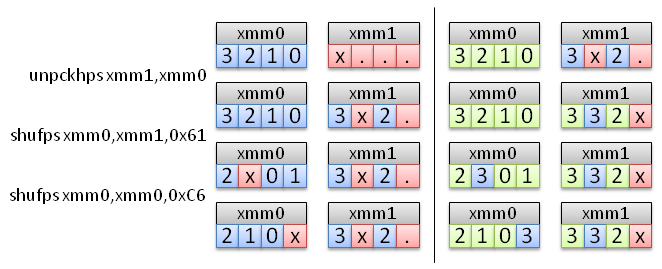How fast can we compute 1D gradient?
Eric Bainville - Oct 2009SSE vector right shift
In this section, we are looking for the most efficient solution to shift a float in[n] vector right by one element. The output float out[n] is defined as:
out[0] = 0 out[i] = in[i-1] if i>0
The puzzle is to use the SSE instructions of the previous page to shift the vector. After trying "by hand" for a few hours, I gave up and wrote a small program to check all sequences of instructions. The results are quite interesting: at least 3 instructions are needed (excluding the memory load and store) and there are only 4 solutions using 3 instructions. Here are the four solutions, the input is in xmm0, and the output too.
unpckhps xmm1,xmm0 shufps xmm0,xmm1,0x61 shufps xmm0,xmm0,0xC6 unpckhps xmm1,xmm0 shufps xmm0,xmm1,0x64 shufps xmm0,xmm0,0xD2 unpckhps xmm1,xmm0 shufps xmm0,xmm1,0x91 shufps xmm0,xmm0,0x87 unpckhps xmm1,xmm0 shufps xmm0,xmm1,0x94 shufps xmm0,xmm0,0x93

Instead of an __asm block with assembly instructions, we will use the SSE intrinsics. The corresponding code is:
__m128 r0,r1;
r1 = _mm_setzero_ps();
for (int i=(n>>2);i>0;i--)
{
r0 = _mm_load_ps(in);
in += 4;
r1 = _mm_unpackhi_ps(r1,r0);
r0 = _mm_shuffle_ps(r0,r1,0x61);
r0 = _mm_shuffle_ps(r0,r0,0xC6);
_mm_store_ps(out,r0);
out += 4;
}
It runs at 1.0 cycles/float. Unrolling the loop to process 8 floats per iteration, we reach 0.9 cycles/float. The three unpack/shuffle instructions all use the same execution port of the processor, so the best execution time is at least 0.75 cycles/float.
With this code already running at 1.0 cycles/float and the C code running at 1.6 cycles/float, it is very unlikely we will be able to compute the corresponding left shift and the subtraction in 0.6 additional cycles/float. Using SSE to compute a single line gradient is probably not better than the C code. However, we may have more luck by computing the gradient of 4 vectors in parallel.
We need to work on blocks of 4x4 pixels:
- Load one block (4 movaps).
- Transpose it (8 shufps).
- Compute the gradient (4 subps).
- Transpose the block again (8 shufps).
- Store the block (4 movaps).
This sequence must be adapted to finish computation and store the previous block after the next one is loaded, because we need its first column to compute the last column of the previous block.
After various attempts, the best I could reach was 1.9 cycles/float. The load/transpose/store operation runs at 0.83 cycles/float, giving an estimate of 2.1 cycles/float for first computing the transpose and storing it in place, then compute the gradient, and transposing again.
| SSE gradient : SSE instructions | Top of Page | SSE dot product |
